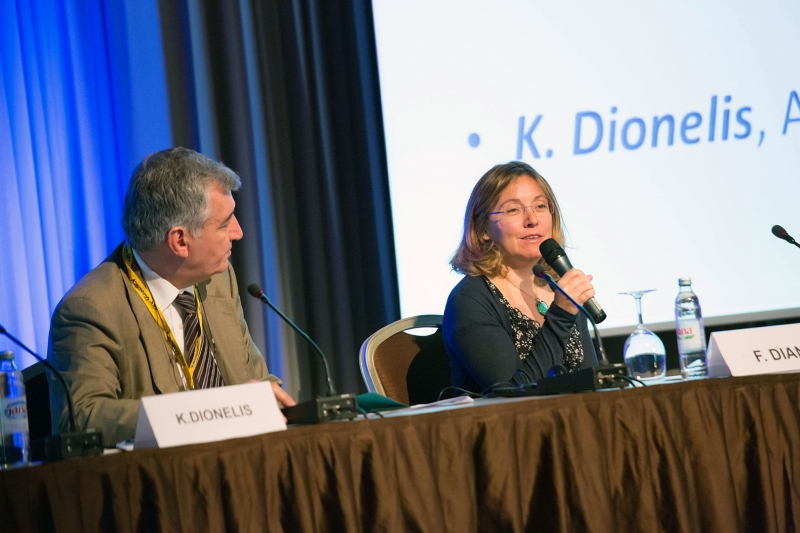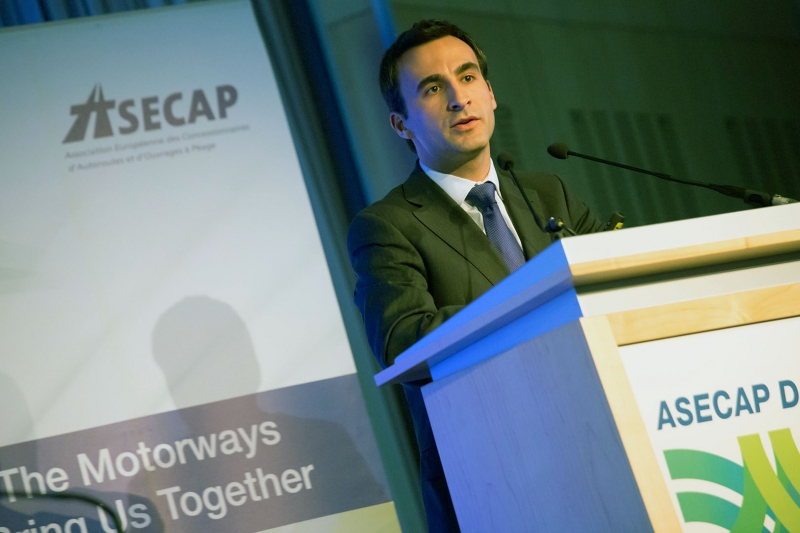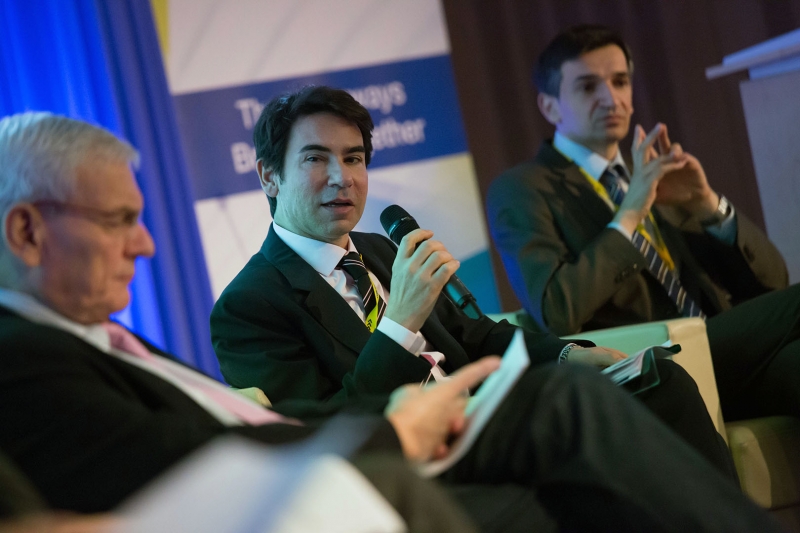The 41st annual ASECAP Study and Information Days were held in the Croatian coastal city of Dubrovnik on 26 to 28 May. The event explored the role of toll roads in promoting sustainable growth in Europe and had a particular focus on how Intelligent Transport Systems (ITS) could contribute. GNSS is a leading enabler of ITS and the European GNSS Agency (GSA) played a prominent role in proceedings.
ASECAP (Association Européenne des Concessionnaires d’Autoroutes et d’ouvrages à Péage) brings together organisations that today span more than 46 000 kilometres of tolled motorways, bridges and tunnels across 21 European countries. Its ‘ASECAP Days’ is an important meeting that discusses future technology and policy options for European transport infrastructure.
The 41st ASECAP Days conference in Dubrovnik was an occasion for GSA to emphasise the opportunity offered by GNSS in implementing fair and flexible policies to support sustainable mobility in Europe.
Cooperative actions
 In the main opening session on ‘Cooperation with key partners’ Ms. Fiammetta Diani from GSA and ASECAP General Secretary Mr. Kallistratos Dionelis presented progress in this area. ASECAP and GSA signed a Memorandum of Understanding in 2011 to explore how European GNSS technology, such as EGNOS and Galileo, can add value to road infrastructure operators and identify concrete actions to capture this value.
In the main opening session on ‘Cooperation with key partners’ Ms. Fiammetta Diani from GSA and ASECAP General Secretary Mr. Kallistratos Dionelis presented progress in this area. ASECAP and GSA signed a Memorandum of Understanding in 2011 to explore how European GNSS technology, such as EGNOS and Galileo, can add value to road infrastructure operators and identify concrete actions to capture this value.
This led to a joint roadmap designed to take advantage of new GNSS services in the evolution of tolling schemes and in ITS deployment in general. Five initial actions had been identified and were described by Ms. Diani. These actions are:
- Identification of GNSS-DSRC (Dedicated Short-Range Communications – a tolling technology widely used in Europe) coexistence and interoperability;
- An analysis of strengths and weaknesses of GNSS in tolling operations;
- Monitoring and assessment of the legal framework, research projects and other Road User Charging (RUC) developments beyond Europe;
- Optimisation of cross-border / multi ETC (Electronic Toll Collection) enforcement; and
- Assessment of the potential of new applications and new markets.
To implement these actions a task force of ten GSA and ASECAP experts had been formed. Its initial kick-off meeting was held at the Dubrovnik conference and attracted great interest: a very promising start to this important initiative.
Ms. Diani also described the GNSS enabled eCall system that is being implemented in all new cars across Europe and will make a major contribution to improved road safety and GNSS’s role in enabling digital tachographs and monitoring of transportation of dangerous goods.
GNSS for Road User Charging
 On the second day of the conference the status of the Galileo programme was presented by the GSA’s Alberto Fernández Wyttenbach during the technical session on ITS. He reinforced the message of the significant contribution that European GNSS is making in the ITS sector, but especially in Road User Charging.
On the second day of the conference the status of the Galileo programme was presented by the GSA’s Alberto Fernández Wyttenbach during the technical session on ITS. He reinforced the message of the significant contribution that European GNSS is making in the ITS sector, but especially in Road User Charging.
“EU GNSS brings value at no additional cost,” claimed Mr. Fernández Wyttenbach. He noted the high level of accuracy that the current EGNOS enhanced GPS offered and, with the accelerating deployment of the Galileo constellation, accuracy and reliability will continue to increase.
Thus, Mr Fernández Wyttenbach’s main message was that GNSS is becoming the technology of choice for free-flow RUC. “Galileo will be the main driver of the second generation of GNSS in road tolling schemes in Europe,” he said. GNSS was a system that did not recognise borders and therefore offered a truly pan-European approach.
GNSS is already starting to speed up in European RUC with the use of EGNOS in the new French ECOTAXE scheme and the forthcoming Belgian GNSS tolling scheme for trucks specifying a preferred architecture that is EGNOS and Galileo-ready. Other European countries were also working on GNSS schemes.
With Galileo deployment and all its advantages, automotive receivers readily available and European research funds available to foster innovation Mr. Fernández Wyttenbach called on ASECAP members to engage with European GNSS to truly enhance their RUC applications.
Green mobility
 The second day of the conference also saw a contribution by Christos Economou, Deputy Head of Land Transport at the European Commission DG MOVE. He participated in the Plenary Session: ‘Is the crisis over? Road tolling as a key factor for green mobility leading to sustainable growth.’ Mr. Economou presented the status of the Commission’s public consultation launched on RUC and gave some insights on the possible policy measures that were under consideration.
The second day of the conference also saw a contribution by Christos Economou, Deputy Head of Land Transport at the European Commission DG MOVE. He participated in the Plenary Session: ‘Is the crisis over? Road tolling as a key factor for green mobility leading to sustainable growth.’ Mr. Economou presented the status of the Commission’s public consultation launched on RUC and gave some insights on the possible policy measures that were under consideration.
The European Commission is aiming to make a proposal in Autumn 2013 and one possible measure is to phase out vignettes for HGVs to stimulate the deployment of fairer electronic distance-based road charging. This will allow the possibility of non-revenue neutral, mandatory congestion-charging schemes that cover all vehicles.
Other possible policies include simplification of the current legal framework to facilitate deployment of RUC by Member States and improve consistency between systems, to promote greater transparency and reduce price discrimination currently experienced by occasional users of the system.
Finally Mr. Economous anticipated measures to foster interoperability of electronic tolling systems across Europe. This was an important step to reduce operating costs and achieve a ‘borderless’ fully interoperable EU tolling area. And, of course, GNSS has a major enabling role in achieving this goal.
Media note: This feature can be republished without charge provided the European GNSS Agency (GSA) is acknowledged as the source at the top or the bottom of the story. You must request permission before you use any of the photographs on the site. If you republish, we would be grateful if you could link back to the GSA website.